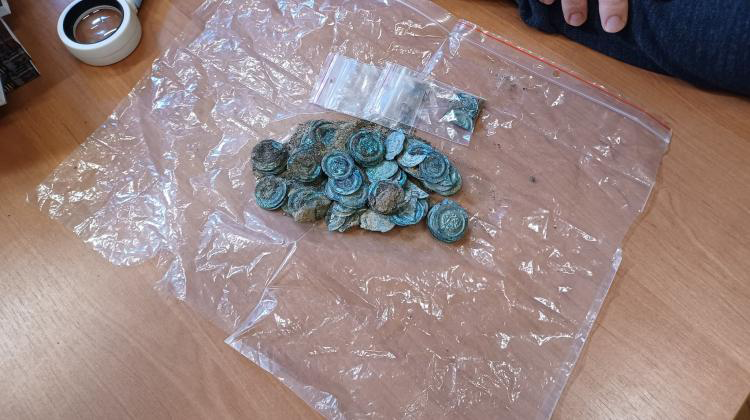A hoard of approximately 100-150 coins, initially identified as the so-called Silesian bracteates, was discovered during a rescue archaeological excavation in Szprotawa, Poland.
The discovery was announced by Lubuskie Voivodeship Conservator of Monuments Dr. Barbara Bielinis-Kopeć.
In the area of a former burgage plot, located on one of the main streets connecting the market square with the Głogowska Gate, a textile bag containing coins in a good condition was found. After a preliminary examination, it was determined that the coins were Silesian bracteates, minted in 1250-1300. Bracteates contain a large percentage of silver, which is why there is a delicate, greenish patina on the surface of the coins.
The rescue excavationwas conducted under the supervision of archaeologist Radosław Kuźbik from the Iskander company.
The discovered coins were arranged in cylinder piles. It is not yet known why the coins were deposited in this way.
“In the case of cash deposits, the inevitable question is who concealed it, when and why. Specialists will want to answer this question in the near future. Currently, however, we can assume that it was so-called petty cash belonging to a rather wealthy person”, according to the announcement.
A bracteate (from the Latin word “bractea”, meaning plate) is a coin minted on one side from a thin plate of soft base. These “wide” bracteates, which were eye-catching and quite rare coins, were introduced in Silesia after 1250. In the first half of the 14th century, they were replaced by a thicker coin, the so-called quarterly.
The Głogowska Gate in Szprotawa was a fortified entrance to the city of in the Middle Ages. Rescue archaeological excavations in the area have been carried out since July, in view of the road reconstruction. Surveys revealed the basements of tenement houses built there since the 1840s.
The history of Szprotawa dates back to the time before 1000. On this date, the chronicler Thietmar mentions a settlement of the Dziadoszyc tribe called Ilva or Ilua – some see it as today’s Iława, the western district of the city, where Bolesław the Brave was supposed to meet with Emperor Otto III, who was on his way to a convention in Gniezno.


